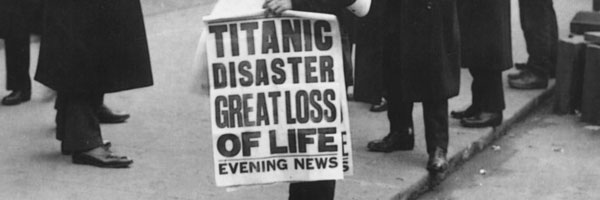 The sinking of the Titanic might be one of the most famous ship wrecks in history. In preparation for seeing the exhibit on display at the Indiana State Museum, I have been doing a ton of research and learning all I can about the ship itself, as well as the night the ship went down. It has been a long time since that boat sank, but I am really looking forward to seeing this exhibition next week. We will be going to see the exhibit with an open mind and I can’t wait to share those stories with you. I hear there are over 200 pieces on display from the original wreckage. It’s a sad topic, and one that I am glad I have the chance to share with you here. Below you will find a long list of frequently asked questions about the ship and the wreck.
The sinking of the Titanic might be one of the most famous ship wrecks in history. In preparation for seeing the exhibit on display at the Indiana State Museum, I have been doing a ton of research and learning all I can about the ship itself, as well as the night the ship went down. It has been a long time since that boat sank, but I am really looking forward to seeing this exhibition next week. We will be going to see the exhibit with an open mind and I can’t wait to share those stories with you. I hear there are over 200 pieces on display from the original wreckage. It’s a sad topic, and one that I am glad I have the chance to share with you here. Below you will find a long list of frequently asked questions about the ship and the wreck.
Why was Titanic built?
Although Titanic is best known for carrying the rich and famous between Europe and the United States, the ship actually had several purposes:
- To carry British and US mail – hence the full name of the ship is Royal Mail Ship (RMS) Titanic.
- To carry general cargo and frozen meat since at that time Europe could not produce enough livestock to meet its own needs.
- To carry first-class passengers in great luxury, second-class passengers in great comfort and third-class passengers with great economy.
- To fly the flag of Great Britain and uphold national honor.
Even though Titanic was ultimately owned by American business interests, the ship was built in a British yard, operated by British subjects, manned by British crews and perceived by the public as a British ship.
How large was Titanic? How many crew were on board?
Titanic was 882 feet 9 inches long, 92 feet 6 inches in breadth. Titanic weighed 46,329 tons (103,575,360 pounds). There were 1,316 passengers on board: 325 in first-class, 285 in second, and 706 in third-class. At the time of the sinking, the ship’s crew consisted of 885 men and women divided between three departments: Deck Department, 66; Engine Department, 325; Victualing (Passenger Care) Department, 431. Not included in this list are the eight members of the ship’s band who were technically from another company and traveled under second-class tickets.
Who built Titanic?
Titanic was constructed by the shipbuilding firm of Harland & Wolff at their Queen’s Island Works in Belfast, Ireland. Edward Harland acquired the yard in 1859. A few years later, G. W. Wolff was taken into the partnership and in 1862 the name changed to Harland and Wolff. By the time of Titanic’s construction, both these men had either died or gone into retirement, and the company placed under the management of Lord Pirrie.
Why was Titanic said to be unsinkable and where did the story come from?
Titanic was described in the popular press as “practically unsinkable”. This was not unusual – for decades, ships had watertight compartments to limit flooding in case of an accident, and the press used this phrase as a matter of routine for many years. After Titanic sank, the story of her loss was turned into a modern fable and the original description “practically unsinkable” became just “unsinkable” in order to sharpen the moral of the story. No educated person in 1912 believed that Titanic was truly unsinkable, but it was difficult to imagine an accident severe enough to send her to the bottom.
Was Titanic warned about the icebergs in the area?
Yes, the first ice warning came in by wireless at 9:00 the morning of the collision from the Cunard Liner Caronia. As the day progressed, several additional wireless warnings came in from ships in the region warning of ice ahead.
How long did it take Titanic to sink?
Titanic struck the iceberg at 11:40 PM on Sunday, April 14, 1912 and sank 2 hours, 40 minutes later at 2:20 AM the next day.
Where is the wreck site of Titanic?
Titanic’s wreck site is located 963 miles northeast of New York and 453 miles southeast of the Newfoundland coastline. Titanic lies 2.5 miles beneath the ocean surface, where the pressure is 6,000 pounds per square inch.
What ships came to Titanic’s rescue and what ships did not?
Titanic’s distress call was received by several ships the night of the disaster including the Carpathia, Mount Temple, Virginian, Baltic, Caronia, Prinz Fredrich Wilhelm, Frankfurt and the Titanic’s sister ship the Olympic. Initially, several of these ships altered course towards the collision site, but when it became apparent that Carpathia alone would make it to the scene of the accident in reasonable time, they resumed their previous courses. One ship, the Leyland Line’s Californian was only a few miles distant from the Titanic. The Californian had stopped for the night in pack ice because her Captain felt it too dangerous to proceed through the ice field in the dark. Although fitted with wireless, the Californian’s operator had turned in for the night and missed the distress call. To this day, there is considerable controversy as to whether the Californian’s deck officers were negligent in not making a more aggressive investigation into rockets and lights seen in the distance.
Why didn’t Titanic carry enough lifeboats?
Titanic’s lifeboat capacity was governed by the British Board of Trade’s rules, which were drafted in 1894. By 1912, these lifeboat regulations were badly out of date. The Titanic was four times larger than the largest legal classification considered under these rules and by law was not required to carry more than sixteen lifeboats, regardless of the actual number of people on board. When she left Southampton, Titanic actually carried more than the law required: sixteen lifeboats and four additional collapsible boats. The shipping industry was aware that the lifeboat regulations were going to be changed soon and Titanic’s deck space and davits were designed for the anticipated “boats for all” policy, but until the law actually changed, White Star was not going to install them. The decision seems difficult to understand today, but in 1912, the attitude towards accident prevention was much different. At the turn of the century, ship owners were reluctant to exceed the legal minimum because lifeboats took up most of the space on first and second-class decks. Boats were expensive to purchase, maintain, and affected a ship’s stability. Finally, in the years before the Titanic disaster, it was felt that the very presence of large numbers of lifeboats suggested that somehow the vessel was unsafe. Oddly, the same reluctance showed up as late as the 1950s for automobile seat belts. Car makers at that time were also reluctant to install seat belts because the belts seemed to imply there was something unsafe about the car.
Were third-class passengers deliberately kept below decks?
Both the British and American inquiries found that there was no evidence to suggest that third-class passengers were deliberately kept below decks, although it is true that third-class passengers did not make their way to the boat deck until very late in the sinking. A reasonable explanation is that the ship’s officers were overwhelmed by the disaster and simply overlooked sending specific orders to evacuate third-class. White Star had formulated no emergency plans for this type of accident and the ship’s officers were fully preoccupied with the crisis of damage control and the launch of lifeboats. In an attempt to provide for an orderly evacuation, third-class stewards held passengers below waiting for orders that nobody thought to give.
Were only women and children allowed in the lifeboats?
Traditionally, first seats in lifeboats are given to women and children, with men filling up the late leaving lifeboats; however, given Titanic’s lifeboat shortage, this tradition meant that the casualty list was more heavily male. On the port side of Titanic, the lifeboat launching were supervised by Officer Lightoller, who took this order literally, preventing any men except the boat crews from embarking. Early in the sinking, women were naturally reluctant to abandon a ship that did not seem at all to be in trouble, and as a result, many of these boats were sent away only partially full. On the starboard side, Officer Murdoch interpreted the order to mean “women and children first on deck” – and only after all the seats had been offered to women, could any men on hand, who wished to evacuate, do so.
How many survivors are alive today?
The last living survivor, Millvina Dean, recently passed away on May 31, 2009 as the oldest survivor of Titanic at age 97.
Can Titanic be raised?
Sadly, even if the technology existed to raise it from the seabed, the wreck is far too fragile to withstand lifting and transportation.
Who discovered the wreck?
The location of the wreck was discovered by Dr. Robert Ballard and Jean Louis Michel in a joint US/French expedition on September 1, 1985 at 1:05 AM.
As you can see, there are a lot of facts about this ship. For instance, I was not aware that the last remaining survivor had passed. The story of the Titanic lives on, while the wreck sits on the bottom of the ocean for eternity.




I am really excited to see the exhibit at the Indiana State Museum. It should be an amazing experience. I am a bit of a history buff. Wife and kids hate it, but I will drag them anyway!
I can’t wait to see it either. I have always been attracted to that wreck, and this my chance to see it up close and personal. I will also be interviewing one of the people behind the scenes; the lady behind the RMS Titanic organization! Lots of great ship wreck content coming.
Speaking of ship wrecks, when I was in Aruba earlier this month I dove my first wreck. There is NOTHING that compares to breathing underwater and literally swimming through hallways of a ship wreck. It. Was. Insane! Anyway, I love wrecks and now that I get to dive them all the better. Of course, the Titanic is in freezing cold water and over 2 miles below the surface.
yeet